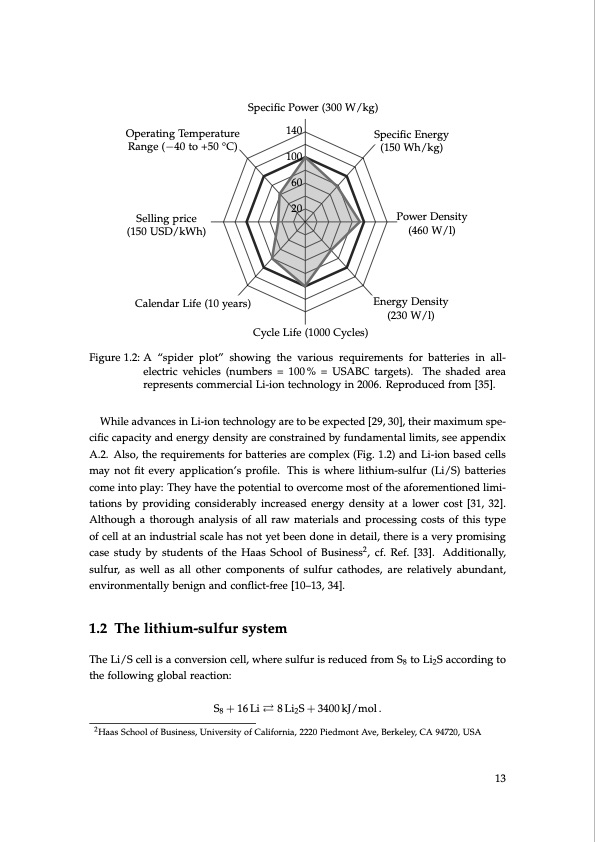
PDF Publication Title:
Text from PDF Page: 013
Specific Power (300 W/kg) Operating Temperature Range (−40 to +50 °C) Selling price (150 USD/kWh) Calendar Life (10 years) 140 Specific Energy 100 (150 Wh/kg) 60 20 Cycle Life (1000 Cycles) Power Density (460 W/l) Energy Density (230 W/l) Figure 1.2: A “spider plot” showing the various requirements for batteries in all- electric vehicles (numbers = 100% = USABC targets). The shaded area represents commercial Li-ion technology in 2006. Reproduced from [35]. While advances in Li-ion technology are to be expected [29, 30], their maximum spe- cific capacity and energy density are constrained by fundamental limits, see appendix A.2. Also, the requirements for batteries are complex (Fig. 1.2) and Li-ion based cells may not fit every application’s profile. This is where lithium-sulfur (Li/S) batteries come into play: They have the potential to overcome most of the aforementioned limi- tations by providing considerably increased energy density at a lower cost [31, 32]. Although a thorough analysis of all raw materials and processing costs of this type of cell at an industrial scale has not yet been done in detail, there is a very promising case study by students of the Haas School of Business2, cf. Ref. [33]. Additionally, sulfur, as well as all other components of sulfur cathodes, are relatively abundant, environmentally benign and conflict-free [10–13, 34]. 1.2 The lithium-sulfur system The Li/S cell is a conversion cell, where sulfur is reduced from S8 to Li2S according to the following global reaction: S8 +16Li 8Li2S+3400kJ/mol. 2Haas School of Business, University of California, 2220 Piedmont Ave, Berkeley, CA 94720, USA 13PDF Image | Lithium-Sulfur Battery: Design, Characterization, and Physically-based Modeling

PDF Search Title:
Lithium-Sulfur Battery: Design, Characterization, and Physically-based ModelingOriginal File Name Searched:
Dissertation_David_N._Fronczek_The_Lithium_Sulfur_Battery.pdfDIY PDF Search: Google It | Yahoo | Bing
Sulfur Deposition on Carbon Nanofibers using Supercritical CO2 Sulfur Deposition on Carbon Nanofibers using Supercritical CO2. Gamma sulfur also known as mother of pearl sulfur and nacreous sulfur... More Info
CO2 Organic Rankine Cycle Experimenter Platform The supercritical CO2 phase change system is both a heat pump and organic rankine cycle which can be used for those purposes and as a supercritical extractor for advanced subcritical and supercritical extraction technology. Uses include producing nanoparticles, precious metal CO2 extraction, lithium battery recycling, and other applications... More Info
| CONTACT TEL: 608-238-6001 Email: greg@infinityturbine.com | RSS | AMP |